With recent fluctuations in the US housing market, investors, homeowners, and potential buyers are all asking the question: Are home prices dropping or merely stabilizing after a period of rapid growth? The answer to this, among other housing market predictions, will be a major determinant of investment strategies over the next 5 years.
At Defy Mortgage, we specialize in unconventional mortgage solutions for homebuyers, homeowners, and investors. Whether you’re an entrepreneur, freelancer, or real estate investor, our 75+ non-traditional lending options, ranging from DSCR loans to cash-out refinances, can be tailored to fit your unique financial situation. With fast, reliable pre-approvals and dedicated end-to-end support, we can guarantee that your mortgage experience will be smooth and stress-free.
In this blog, we’ll bring you the latest in home price news and what that means for both homebuyers and investors. We’ll also cover the various factors affecting home prices, and which types of regions are experiencing price slowdowns or continued appreciation.
Let’s get to it!
Understanding the Current Housing Market Trends
The US real estate market entered 2025 with a growing trend of stabilization. That said, this trend tends to manifest differently across regions. So, to answer the question, “Are home prices dropping?”, prices are still climbing in markets across the US, just more slowly.
As for when home prices will finally drop, the answer to that question is complex, but the general consensus is that prices will continue climbing through the end of the decade. A housing crash is unlikely.
That said, prices are actively declining in certain areas, such as Austin, Texas, and New Orleans, Louisiana, while they show no signs of slowing down in others, like Phoenix, Arizona, Massachusetts, Wisconsin and Colorado Springs, Colorado. Let’s explore the various reasons for these price movements.
The Role of Home Appreciation in Price Trends
Home appreciation refers to the increase in a property’s value over time. The greater the average appreciation in an area, the faster the price growth of properties within it. However, annual home appreciation also varies on an individual basis, with more up-to-date and maintained properties appreciating faster.
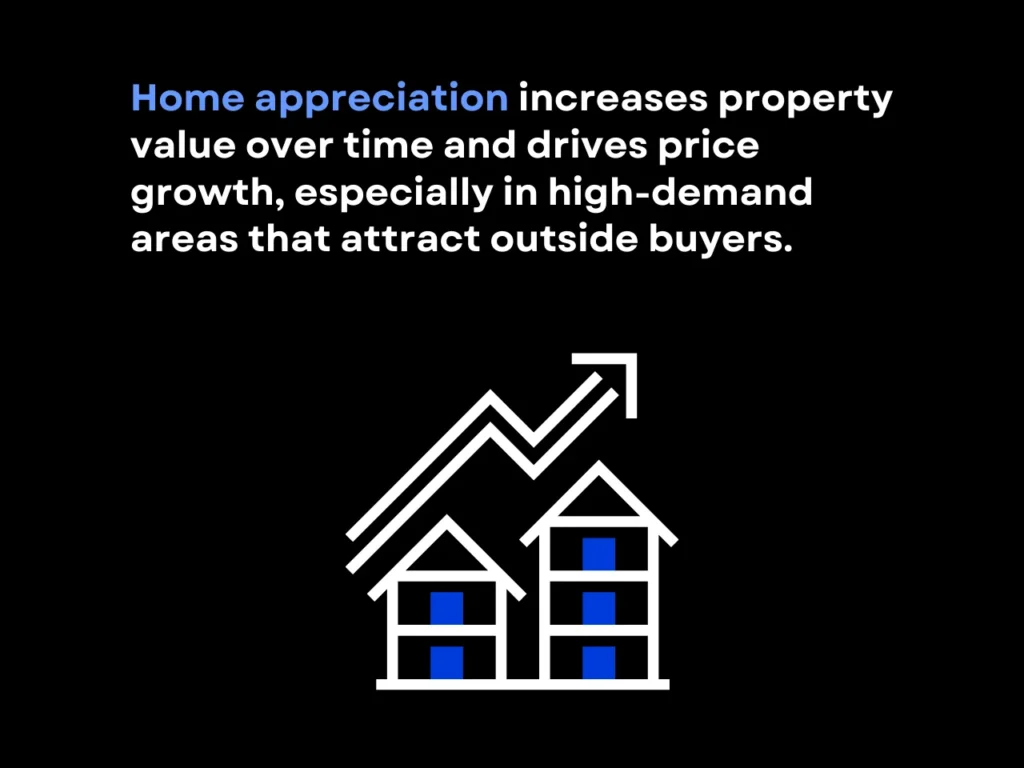
The market type also plays a role in how fast a property appreciates. An increased interest in suburban areas causes appreciation booms in areas like Washington D.C., while rural areas have also seen increased appreciation as buyers seek affordability and more living space.
When an area is well-known to have high appreciation, outside buyers are likely to invest in it, adding more upward pressure to the already high home price growth. This is most apparent in states like Connecticut and Hawaii, which historically has one of the highest annual appreciation rates in the US. Consequently, Hawaii also has one of the highest home prices in the US, where almost a quarter of all home purchases are made by out-of-state buyers.
Key Indicators That Determine Market Direction
Several economic and real estate indicators signal the direction of the housing market, and determine whether there could be a housing market correction. Let’s touch on a few of them:
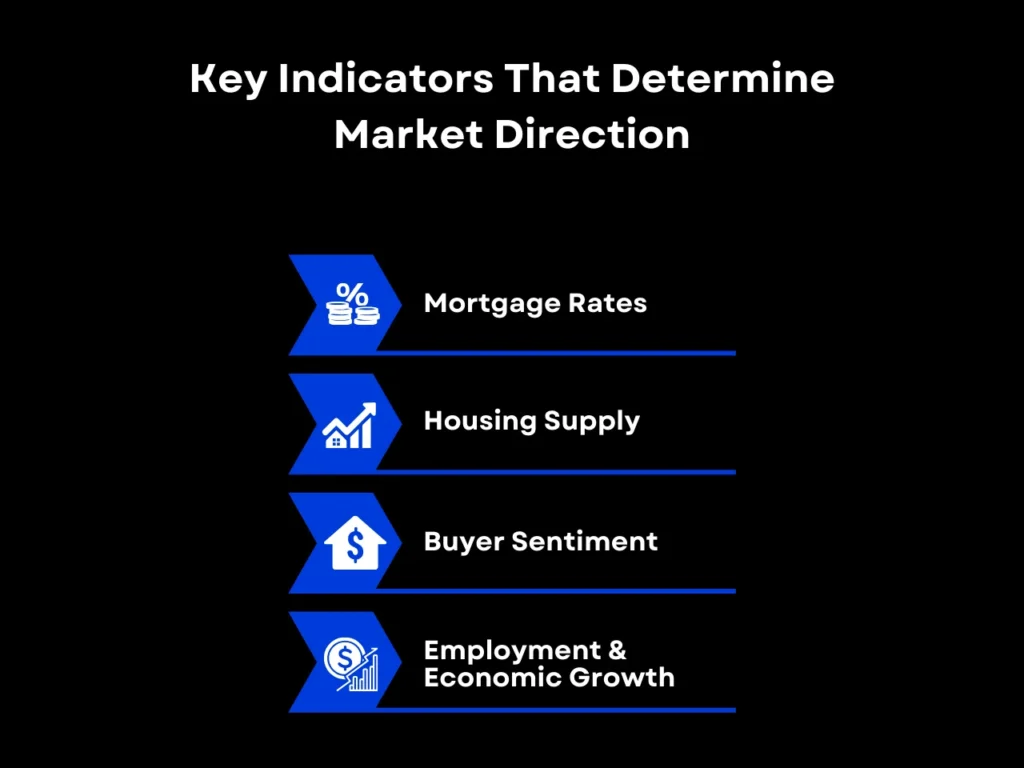
Mortgage Rates
While mortgage rates directly affect home affordability, they are indirectly influenced by various factors, ranging from macroeconomic pressures such as inflation and Federal funds rate cuts to regional effects like the local job and housing market.
As of April 2025, mortgage rates have begun retreating from their highs in 2023 and 2024, and have remained in the mid-6% range. Fannie Mae predicts that the 30-year fixed-rate mortgage will fall to an average of 6.5% by the end of 2025, falling further to 6.2% by 2026.
In general, a lower mortgage rate often leads to higher demand for housing inventory, as homebuyers seize the opportunity to lock in a better rate before it could recover. In this case, housing prices might increase in response to the increased demand.
Housing Supply
Increased housing supply can stabilize or even lower prices, while a lack of inventory tends to keep prices elevated. For example, we’re beginning to see home price hikes slow down due to an increased supply of homes in places like Honolulu and Austin, Texas, due to a mix of new construction and falling demand. Austin experienced a particularly significant surge in housing supply, with a 35.5% boost in its inventory between 2020 and 2024, resulting in significant median price drops from its 5-year high of $659.500 in May 2022 to $512,500 in February 2025, much closer to its February 2020 median sale price of $400,000.
Buyer Sentiment
Economic uncertainties and policy changes can influence buyer confidence and demand. High inflation is one of the primary reasons buyers can be discouraged from purchasing homes. When consumers’ purchasing power diminishes, it becomes increasingly challenging for them to commit to major financial decisions such as buying a home. Rising costs of living and expenses can lead to a greater sense of financial insecurity, prompting buyers to delay or reconsider their purchasing plans.
Construction costs can also be a significant factor. According to the US Census Survey of Construction, shortages in materials and lots, as well as rising wages for home builders, can cause newly constructed homes to be priced far above buyer expectations.
Buyer sentiment can be positively incentivized by policies such as the First-Time Homebuyer Tax Credit Act of 2024, which gave tax credits of up to $15,000 for first-time homebuyers. This tax credit was last attempted in 2009 in response to the Great Recession. After it was implemented, home sales rose to 446,000, but quickly fell to 300,000 as soon as the initiative expired.
Employment & Economic Growth
With a strong local economy comes greater purchasing power and more housing demand in the region. As more and more homebuyers enter the market, demand increases, which can drive home prices up if supply can’t keep pace. For example, Buffalo, NY, was named by Zillow as the most competitive US housing market in 2025, topping the list for the second year in a row. According to Zillow, the main reason for this is that Buffalo has the highest ratio of new jobs to new housing permits in the country.
Keep in mind that this can still depend on the prevailing home prices in the area. If the wage growth isn’t enough to make home purchases within reach, locals will stick to renting, which lowers the demand for home ownership.
Regional Differences in Price Stability
Because each area has varying supply and demand dynamics, local economic conditions, and environmental attributes, these unique factors affect price growth and define how homes are priced in that area. Let’s explore these regional differences.

Regional Supply and Demand
Certain regional attributes can alter the available housing supply. For instance, island settings like Hawaii have much less land available, which puts an upper limit on how many homes can be built and drives prices higher. Strict zoning regulations in cities like San Francisco and New York can have a similar effect.
It’s worth noting that many of the places are currently experiencing cooling demand as more buyers are priced out of the market, with an exception being North Carolina.
In some cases, proximity to major industry centers can be enough to make certain housing markets competitive. Conroe, TX, about 40 miles north of Houston, is only a 15-minute drive away from The Woodlands, a high-income job center. This allowed it to quickly gain popularity among middle-class homebuyers.
Local Economic Conditions
Factors like employment opportunities, income levels, infrastructure development, and economic diversification all play important roles in shaping local house prices. For instance, the rapid growth of the tech industry in San Francisco and Seattle attracts a highly skilled workforce, driving up both home values and rental prices. Similarly, the expansion of public transit in cities like Los Angeles has been attributed to rising home prices.
Economic diversification, on the other hand, can lead to more sustainable price growth. San Diego is a great example of this. The city is host to various major industries, from biotech and medicine to defense. Compared to other commercial hubs in CA like San Francisco and Oakland, home prices in San Diego grow much more sustainably without having to experience rapid ups and downs.
Environmental Factors
Frequent hurricanes, floods, volcanic eruptions, and other natural hazards limit the price of homes in affected areas. For example, Puna, Hawaii, is located in a lava zone, where homes are notably cheaper than in the rest of the state.
However, certain environmental traits can be highly beneficial for home appreciation as well. Beachfront properties are highly coveted in most places, and island settings are both desirable and lead to a scarcity of space that limits supply – both factors contributing to Hawaii’s famously high home prices.
Predictions for Housing Prices Over the Next 5 Years
Expert forecasts suggest that the real estate housing market will experience moderate, progressively slowing growth over the next five years. The primary factors influencing this prediction include new construction significantly boosting new inventory, and stubbornly high mortgage rates forcing sellers to lower their asking price to attract buyers.
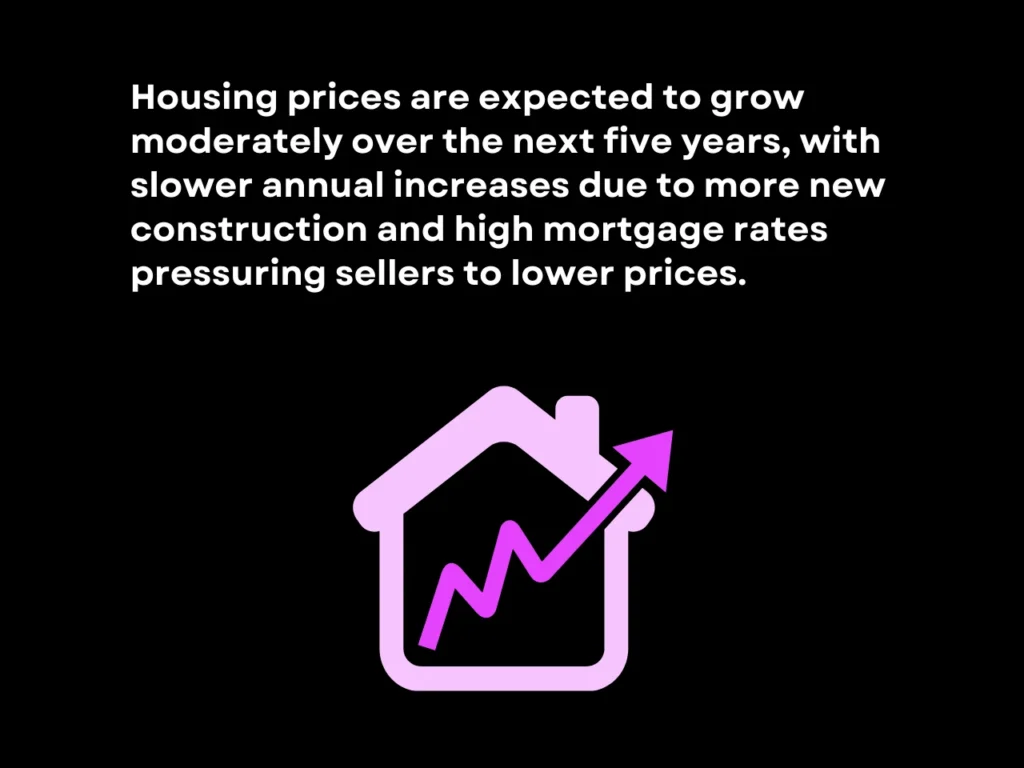
Although these predictions are overall somewhat positive, it may take a few years to see the changes. Fannie Mae projects a 3.5% increase in home prices for 2025, followed by a 1.7% rise in 2026. Similarly, the Mortgage Bankers Association forecasts a 1.3% annual increase for both 2025 and 2026.
What This Means for Homebuyers and Investors
Whether or not home prices are dropping impacts homebuyers and investors slightly differently. For both, the anticipated stabilization in price growth presents an opportunity to enter the market. However, lower home prices also mean that home appreciation has slowed, which may not be as promising for investors with shorter time horizons.
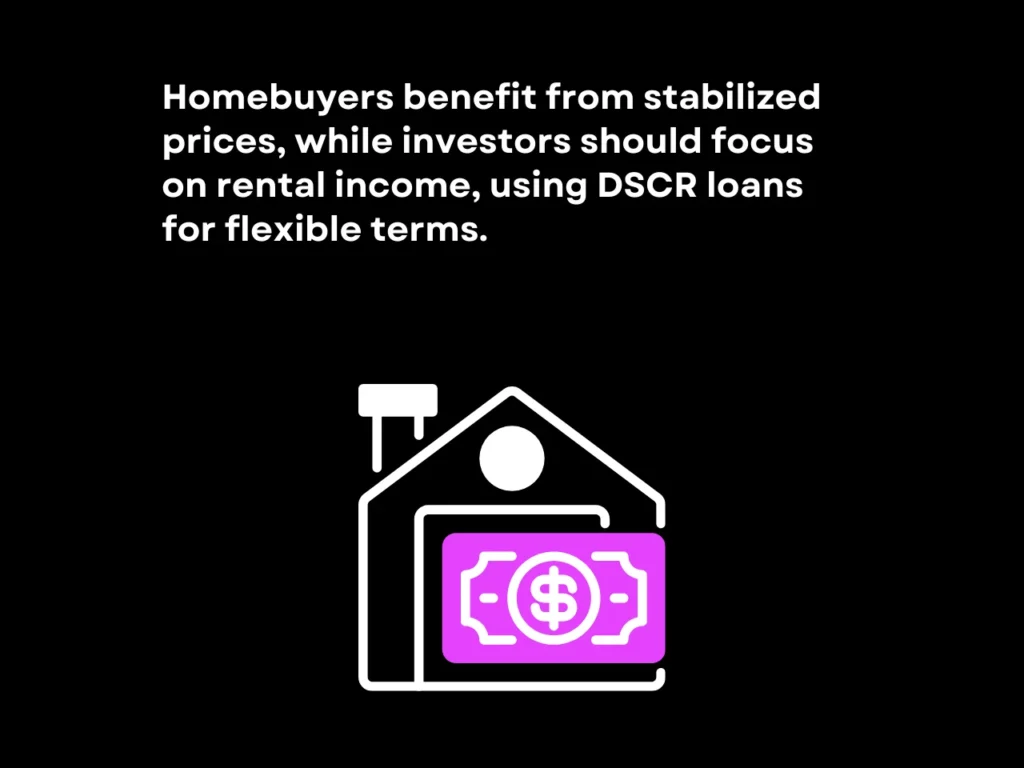
To counteract this, investors can opt to generate consistent rental income while the appreciation catches up over the long run. Since almost 3/4ths of the US population rent instead of own, rental properties can attract a much bigger market than those looking to buy.
This strategy is best paired with a DSCR loan, as the loan terms for this product improve along with the investment property’s cash flow potential. As long as you select a property in a market with healthy rental demand, you can enjoy mortgage rates that can compete with that of conventional loans, high loan amounts, and high LTVs (Up to 85% at Defy). Your eligibility depends entirely on the property’s performance, allowing you to qualify even if you have less-than-perfect credit or a high debt-to-income ratio (DTI).
Are Home Prices Dropping FAQ
Is now a good time to buy a home, or should I wait?
Whether or not it’s a good time to buy a home for you will ultimately depend on your financial situation, the local market conditions in the area you want to purchase in, and your personal goals. Home prices in general are expected to take a few years to stabilize, although mortgage rates are dropping, albeit slowly.
How do I know if a market is stabilizing rather than crashing?
One of the main indicators of stabilization is a gradual rather than steep decline in prices or price growth. You’ll also see renewed buyer activity at adjusted prices. In contrast, a crashing market is marked by rapid price declines, rising inventory from sellers, and collapsing demand. Rapid price drops often follow significant housing oversupply, which isn’t an issue in the US, where there’s currently a housing shortage.
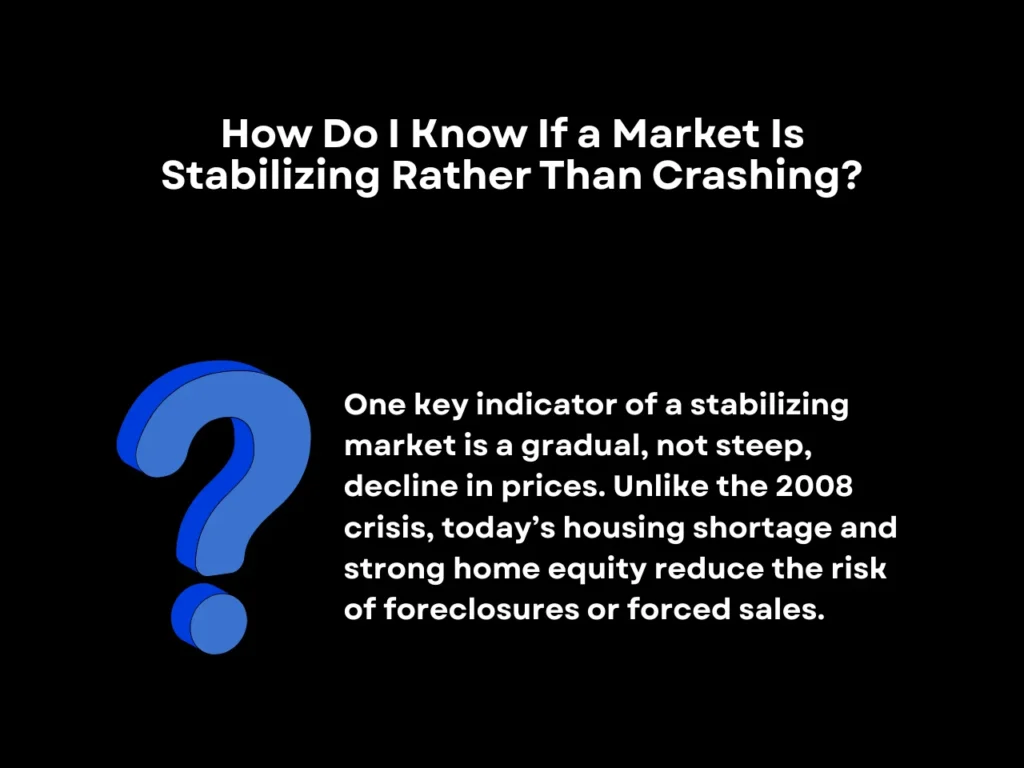
Does Defy offer financing options for investors looking to buy in a stabilizing market?
Yes! Defy Mortgage provides a range of non-traditional financing options tailored to investors’ needs. Our core offerings include DSCR loans, which come with improved rates for properties with high potential cash flow, to further increase the affordability of your investment as real estate prices level off in a stabilizing market.
You can also take advantage of P&L loans and bank statement loans to potentially get higher loan amounts by exhibiting your full earning capacity. We also offer interest-only structures to minimize your monthly payments for a set period of time and asset depletion loans to allow those with high-value liquid assets but lower income to apply, with options for foreign nationals who don’t have a US Social Security Number or credit score.
Can Defy help self-employed borrowers or those using rental income to qualify?
Absolutely. At Defy, we offer flexible non-QM solutions that don’t require tax returns or W-2s, allow qualification through rental income, and provide options for foreign nationals without SSN or FICO scores. For self-employed individuals, bank statement loans and DSCR loans use bank statements or rental income in lieu of traditional W-2 income. DSCR loans are especially aligned with borrowers with rental properties as they offer better terms to rentals with high cash flow potential.
What regions are seeing the biggest home price changes right now?
Regions like Texas and Florida are experiencing significant price corrections due to vastly increased inventory. Meanwhile, parts of the Midwest, like Chicago, have seen large price increases since 2023 for the opposite reason: high demand outstripping existing housing supply due to a slowdown in the construction sector.
Key Takeaway
To recap, the answer to the question of “Are home prices dropping?” is that home prices will continue to climb, but growth is expected to proceed at a more subdued pace by 2030. Regional trends show that areas like Austin, Texas, experiencing significant price declines, may offer the best opportunities for homebuyers seeking affordability.
Across the United States, most regional markets demonstrate remarkable resilience and sustainable growth. In particular, urban areas like San Diego, California, present compelling opportunities for investors. The combination of a desirable climate, thriving job market, and diverse community enhances the appeal for both renters and investors.
Curious about your best options going forward? Reach out to Defy’s mortgage experts and gain specialized guidance on your financial goals.







